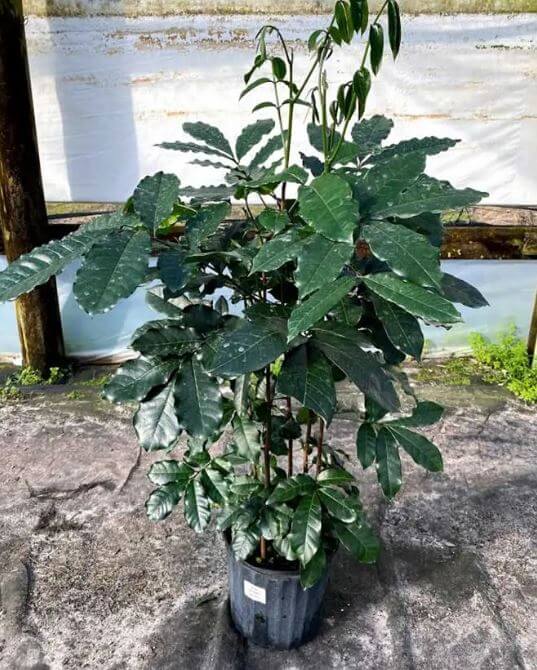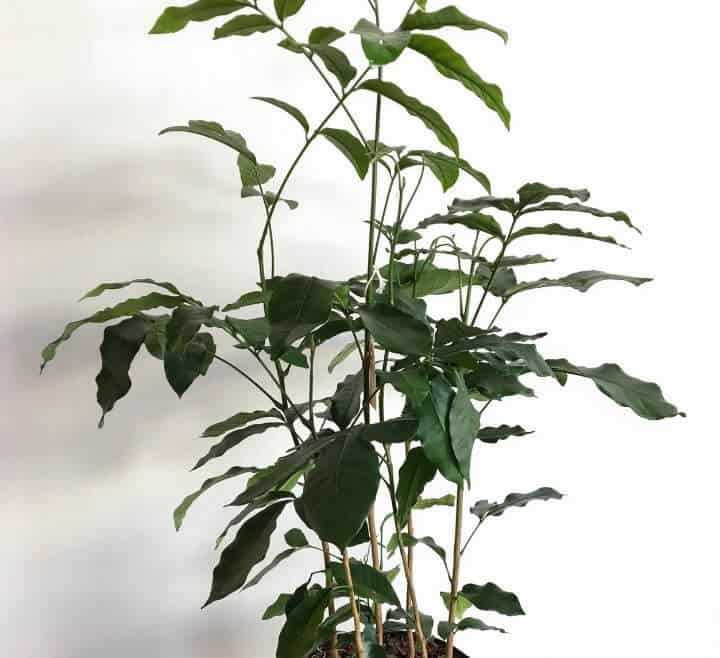Last Updated on January 5, 2023 by a Friendly Gardener
Botanically known as the Trichila Dregeana and a member of the Meliaceae family, this exotic South African native is better known as the Natal Mahogany plant to garden enthusiasts. While not as well-known as many other houseplants, this is a great plant choice for those that tend to overwater. The Natal Mahogany absolutely loves water!
Popular names for the Natal include
- Forest Natal Mahogany
- Forest Mahogany
- Thunder tree
- Cape Mahogany
- Christmas Bells
- Red Ash

Bushy, woody, and hardy, its dark blackish-green foliage is glossy and appealing. Compound foliage can grow to 14 inches and will feature three to five leaflets and a terminal leaflet and leaves can grow to 8 inches in length.
This upright grower can reach seven feet high and four feet wide when cultivated indoors, so you’ll need a spot with ample space. Some say that the Natal Mahogany resembles a Schleffera Amate, but there’s no relation, and this tree is much more forgiving. It adapts well to lower light conditions if it receives sufficient water.
Outside this exotic-looking evergreen can be found growing on the shores of rivers underneath the canopies provided by larger tropical forest trees in areas with lots of rainfall. The main stem or trunk can grow to 30 feet in diameter and approximately 80 feet in height. It can be cultivated in USDA hardiness zones 10 to 12.
While this particular species likes indirect bright light, a Natal Mahogany indoor plant also can grow well under fluorescent lights. This makes it a striking choice for office lobbies, malls, and businesses in general. They will not survive without light.
Creamy white blooms are produced at the beginning of summer. Afterward in late summer, velvety brown fruit capsules appear. Once the capsules open, 6 very distinct seeds will be revealed that are red and black.
Natal Mahogany Plant Care

The most important aspect of successful natal Mahogany plant care is water. The glossy leaves will also require occasional dusting to enable photosynthesis. This will also provide you with an opportunity to inspect foliage for the presence of pests. In winter, expect your plant to enter a rest period.
Soil
The natal thrives best in fertile, humus-rich soil, but it can be cultivated in sandy, loamy, or clay-based soil. Ideally, the soil pH should be alkaline to neutral.
Light

The natal does well in full sun or in the shade. It is highly adaptable to light levels. It also manages well under fluorescent indoor lighting. When placed near a window or light source, rotate your tree weekly to ensure even growth on all sides.
Water
The Natal is much more forgiving than most houseplants when it comes to watering. One way to ensure your plant gets enough water is to place a saucer or dish underneath the plant pot.
The soil bed must always remain evenly moist, not waterlogged, or soggy. It can suffer from continued overwatering so control soil moisture levels weekly. Some plant experts suggest the Natal will need more than one watering per week, but light and temperature will play a role in determining this.
If you are cultivating in an office setting or travel, the Natal Mahogany does very well in self-watering plant containers.
Humidity
As lovers of water, your Natal will do best in high humidity. If your indoor humidity levels are low, consider a space humidifier, or a pebble tray and the occasional misting.
Temperature
The Natal is very frost sensitive, so if you are thinking of growing it outdoors, it should not be in a colder climate. Average home temperatures between 60° and 80°F. should be more than adequate.
Feeding
Not a heavy feeder, the Natal Mahogany plant will benefit from a monthly feeding from the beginning of spring through the fall season. Use a liquid organic houseplant fertilizer that has been diluted.
Pruning
Natals do grow indoors, but in low-light environments, they reach and become leggy. Prune your tree back to its desired shape, as it will branch again.
Potting and Repotting

If your plant is a larger-sized floor plant, plan on repotting it every 18 to 24 months. When repotting, choose a new container that is two to four inches larger in diameter than the actual pot. Do not use a pot that is larger as this could create the conditions for root rot as more soil will contain more water. If you want your plant to remain the same size, trim away a portion of the root ball, and use the same pot with new soil. It is recommended that you repot in spring or summer.
Natal Mahogany Plant Propagation
The Natal is generally propagated from seed, fresh seed should be planted, as drying gradually reduces the seed’s ability to germinate. Plant in one part compost and one part river sand and keep it moist in a well-ventilated, brightly lit spot. Germination may need from 2 to 4 weeks. Seedlings tend to grow rapidly.
Natal Mahogany Plant Problems
While a hardy species, the Natl Mahogany is susceptible to spider mite infestations. If you notice stippling on the foliage the size of pinpricks, mites are present. Treat your tree with organic Neem oil. These plants are also susceptible to scale infestations which may be difficult to see if these parasites attach themselves to the tree’s woody stems. Remove the scale manually and treat it with Neem oil.
Brown or yellow foliage may be an indication of underwatering. If instead leaves have brown edges that look as if they have been bitten, this can be a sign of overwatering.
Soil should be aerated to prevent the risk of soggy soil and root rot.
Natal Mahogany Toxicity

The plant’s bark is highly toxic, so this plant should be kept away from children and family pets. It is known to be used in the production of fish poison.
Natal Mahogany Plant Uses
The Trichila Dregeana has multiple uses. The wood is soft and easily worked to make furniture or carvings. It features a pale pink hue that is evenly grained.
Seeds that have their coatings removed are edible and arils are crushed for a sweet drink or cooked to be served as vegetables. Rich in fat, the fat is often used in oils, ointments, and soaps.
The bark, leaves, oil, roots, and seeds are used for medicinal purposes for a variety of maladies.

